This week we thought we’d take a look at where AFL players are from. The chart below is a pretty good illustration of the most fertile state breeding grounds. We’ve also included Ireland:
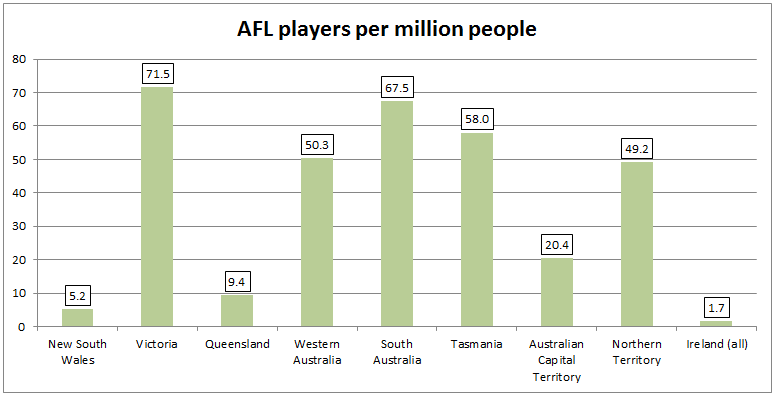
From here we can see that Victoria contributes the most AFL players relative to its population while NSW is only three times as productive as the island of Ireland.
Here’s the basic data:
| Location | Population | Current AFL players | AFL players per million people | Avg games by player |
| New South Wales | 7,670,700 | 40 | 5.2 | 53.6 |
| Victoria | 5,996,400 | 429 | 71.5 | 72.2 |
| Queensland | 4,808,800 | 45 | 9.4 | 58.4 |
| Western Australia | 2,603,900 | 131 | 50.3 | 75.7 |
| South Australia | 1,702,800 | 115 | 67.5 | 79.8 |
| Tasmania | 517,400 | 30 | 58.0 | 52.7 |
| Australian Capital Territory | 393,000 | 8 | 20.4 | 30.3 |
| Northern Territory | 244,000 | 12 | 49.2 | 45.4 |
| Ireland (all) | 6,378,000 | 11 | 1.7 | 24.0 |
We can see then that Victoria has obviously produced the most currently listed AFL players, and also produced the most per head of population. However, South Australians and Western Australians have played more games on average than Victorians:

And as a result the per-capita contribution of football to the AFL is higher by South Australia than by Victoria:
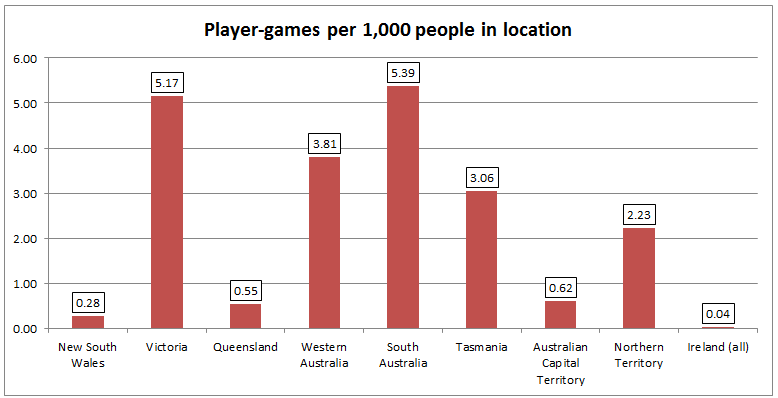
Based on this, we’d call South Australia the purest footy factory in the country, producing many players and players who do well in their careers.
The more successful average careers of SA and WA seems to suggest that marginal Victorians are more likely to be recruited than similarly marginal players from elsewhere. That might be a recruiter bias towards the TAC Cup or clubs leaning towards hometown recruitment.
By contrast, the ACT shows as an emerging football base, currently having twice the players per capita as Queensland and four times NSW, but with a much lower number of games per player. 7 of the 8 have played a senior game, but the ACT players are mostly quite young and new to the league. This is a new situation, as we’d be surprised if there have ever been 8 Canberrans in the league simultaneously before.
When we distribute players and their career games by club we see some interesting effects by club, with Gold Coast having the most Tasmanians and Carlton leading the way in international players:

And here’s each club list by the location of origin of their games experience:
The two most successful Victorian clubs of recent years (Hawthorn and Geelong) have the lowest current share of Victorian-origin players. Only St Kilda is as non-reliant on Victorian experience, thanks to Riewoldt, Gilbert and Armitage from Queensland being among their oldest heads.
The cosmopolitanism of Geelong and Hawthorn probably isn’t a coincidence. It suggests these clubs have gained a competitive advantage by looking elsewhere more than other Victorian clubs have done. This will have been especially important in the time of expansion, as we can see that GWS in particular have a strong Victorian representation, by far the highest share among interstate teams, representing their capture of a lot of elite talent from that state since inception.
Hawthorn, notably, has nearly as high a share of NSW players as GWS, drawing a number from western NSW as well as two Langfords from Sydney.
Finally, we can also use this chart to illustrate the potential dangers of the go-home factor for each club:
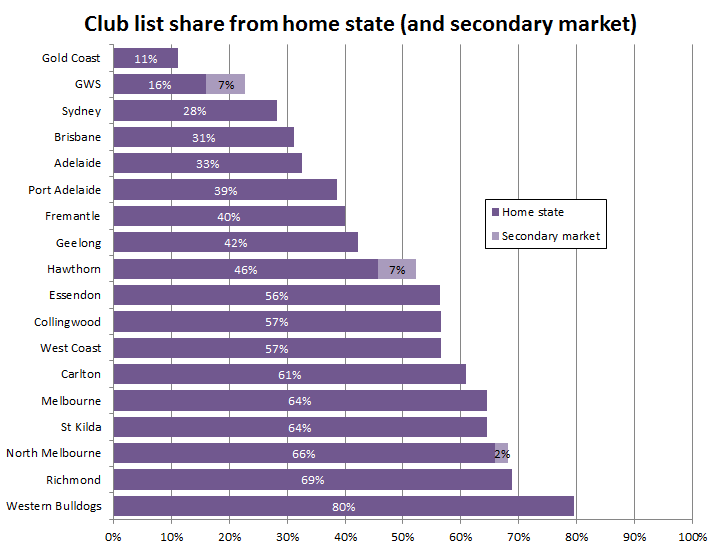
Most Victorian clubs have a higher predominance of hometown players most non-Victorian clubs. Aside from West Coast as an outlier, it’s a completely bifurcated distribution. Structurally then, it looks as if the AFL pool and distribution of clubs more or less guarantees clubs inside Victoria are more able to draft their local players and be less exposed to go-home risks.
A note on the source: This is a custom count of players we have developed, starting with the FanFooty website and making a number of corrections to the “State of Origin” item in each club list. Edits consisted of things like:
- assigning the correct state to NSW-origin Murray Bushrangers (the TAC Cup team covers north of the border too)
- Correcting the state location of certain clubs (eg Dylan Shiel of Edithvale-Aspinvale is not from NSW, and Eastlake is in ACT not NSW)
- shifting some players away from Victoria who only spent their late teenage years there (eg Harbrow, Hawkins, McGlynn, Betts)
- Calling Phil Davis a Canberran because he started out at Marist and only moved to Adelaide around age 14 and that makes him forever a Canberry.
Due to our local knowledge these changes mostly impact ACT and NSW players, but we assume the larger states with more regular recruitment channels are largely accurate. If there’s further inaccuracies it’s probably mostly in Tasmanians and Queenslanders who are wrongly attributed to Victoria due to spending their last pre-draft years there.
Attempting to quantify goal creation
We are of course limited at HPN to publicly available data, but we try to push what we can do with that into new areas. This week we thought about using the goal assist statistic to identify efficient creators of goals. We assume that a lot of goal assists come in the form of passes to players inside 50, so we’ll use that as a comparison:
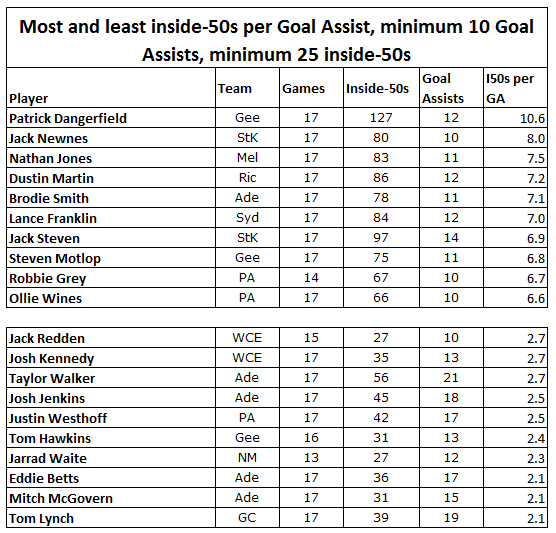
This measure is basically a quick experiment and clearly isn’t a perfect indicator. We seem to have identified that forwards are the most efficient producers of goal assists, as they get them while getting relatively few inside-50s.
Franklin stands out as being the only key forward in the list of most inside-50s per goal – it shows that he is playing quite high and bombing the football into a forward line like the others in the top list tend to do. Compare the four Adelaide forwards who all have high numbers of goal assists per each inside.
Effectively what we seem to have identified is that most players who get a lot of inside-50s aren’t necessarily getting a lot of really high quality ones, rather they’re creating opportunities from sheer quantity. Patrick Dangerfield is the exemplar of this approach. That’s unsurprising, even very efficient teams tend to score goals off well under a quarter of their inside-50s.
What to look for this week
-
Geelong and the Bulldogs should be won in the midfield
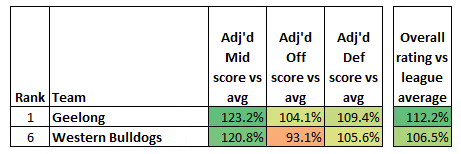
Both Geelong and the Bulldogs have, by our ratings, very strong midfields that generate good inside-50 differentials. Both get plenty of the ball (1st and 4th in disposal differentials, 4th and 1st for contested possession differentials), Geelong is much better in the ruck (6th vs 16th for hitout differentials) but the Bulldogs are the better clearance team (1st vs 4th in clearance differentials) which suggests losing in the ruck never bothers them.
Given Geelong seem to have the edge offensively and defensively, the Dogs are going to have to sustain a positive inside-50 differential to overcome them.
2. A two-Richards forward line?
The loss of Callum Sinclairto the Swans, in addition to the loss of Kurt Tippett, has had commentators talk about the damage done to Sydney’s ruck prospects. However, only twice this season has Sinclair led the hitouts in a Sydney game. This was against against GWS in round 12 when Tippett was injured early, and in round 15 against the Bulldogs when it’s entirely likley Nankervis still attended and lost the majority of the ruck contests.
The rest of the time, Sinclair has been a secondary ruckman and played other structural roles instead. Sinclair’s loss will be a detriment to Sydney’s already shaky forward structures. He is sixth at the club in contested marks and fifth in 1%ers, illustrating his role as a marking target who creates contests even when not taking marks, especialoly in moving the ball up the wings.
Judging by team selections, Sydney’s first port of call will be hoping Nankervis and Naismith can cover the forward structure role as well as ruck.
However with the continued absence of Sam Reid, if the Naismith-Nankervis pairing doesn’t prosper, a dearth of forward targets means over the next month we might see both recent forward convert Richards brothers, both Xavier and Ted, playing tandem roles that Sydney would prefer played by Callum Sinclair and Sam Reid.

